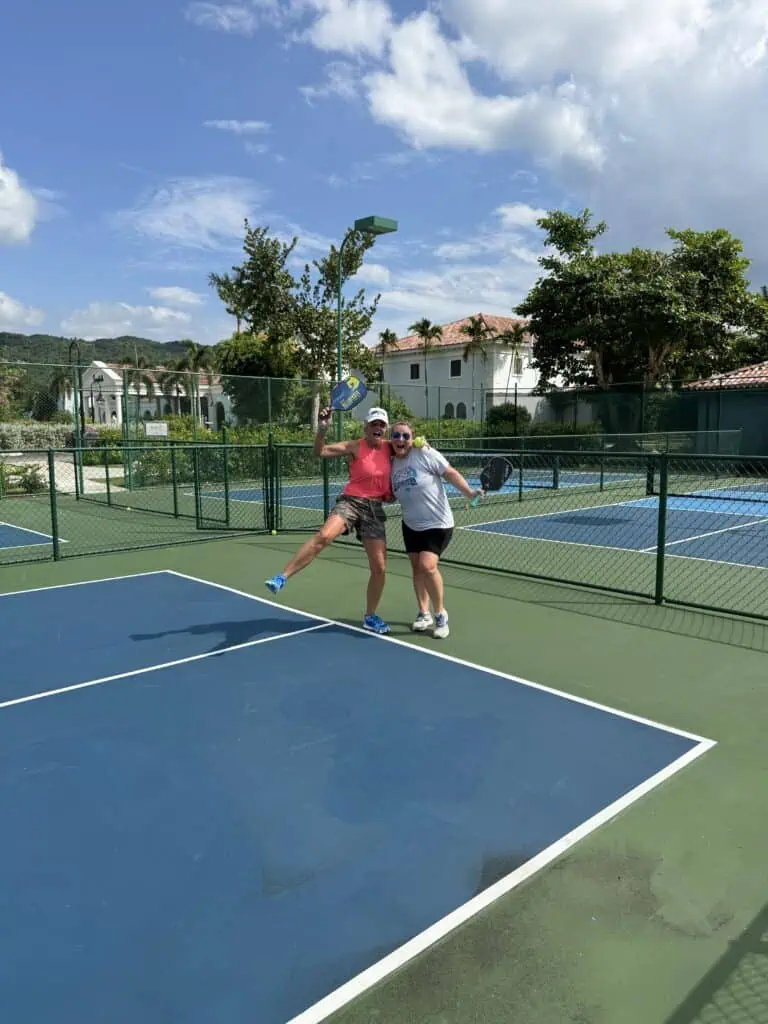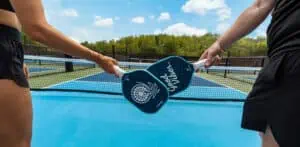Pickleball
Doubles Strategy Tips for Winning Pickleball Games: Improve Your Play

In the world of pickleball, doubles play can feel like a captivating dance, where smooth moves and coordination define success. Yet, many recreational players often overlook key strategies that could easily elevate their game from casual outings to competitive victories. Understanding the ins and outs of court positioning, effective communication, and clever shot selection can turn even the most ordinary matches into thrilling experiences. Whether you’re new to the sport or looking to refine your skills, this article dives into various tactics that can help strengthen your doubles game. Get ready to discover how minor adjustments in strategy can lead to major improvements on the court!
To win at doubles in pickleball, focus on strong communication with your partner, ensuring you both call shots clearly to avoid confusion. Additionally, prioritize court positioning; employing the ‘I’ formation allows you to cover the net effectively while minimizing opponent angles, enhancing your chances of victory.
Mastering Pickleball Court Positioning
Being aware of your position on the court can make a world of difference during a match. First and foremost, grasping what the baseline, transition zone, and non-volley zone (NVZ) are is crucial. The NVZ, often referred to as the “kitchen,” is paramount in controlling play since both players ideally should aim to dominate this area. Holding the NVZ enhances offensive opportunities and compels opponents to react defensively.
Effective positioning requires both partners to coordinate fluidly. If one partner stretches wide to return a shot, the other should instinctively shift toward the centerline to safeguard against potential openings. Picture it as a dance—when one partner moves, the other flows right along, ensuring coverage of gaps while maintaining a tight formation. This unison movement is key to applying pressure on opponents and establishing an offensive stance at the kitchen line.
As you serve and receive, positioning plays a pivotal role in minimizing vulnerabilities. Upon receiving serve, a staggered formation can confuse opponents about where to direct their shots and reduces the chance of a clear target for them to exploit. Always prepare for transitions during gameplay; those moments can be explosive. Lingering too long in the transition zone risks encountering balls unexpectedly at your feet like landmines ready to cause lost points.
Here’s an important tip: Stay engaged! Keeping your partner in sync with subtle movements will help maintain an effective defensive shield while setting up for potential shots.
Imagine how these strategies might mesh together seamlessly on the court—being aware of your position and that of your partner ensures smooth gameplay. With this knowledge, you’ll find it easier to expand your tactics and adaptability during high-stakes match situations.
With solid positioning established as a cornerstone of effective strategy, recognizing the role of seamless communication will further enhance your overall game performance.
Enhancing Team Communication
The essence of good team dynamics in pickleball lies in how effectively partners communicate. It’s not just about talking; it’s about ensuring that both players are on the same wavelength regarding each shot and movement. Strong communication fosters trust, minimizes errors, and often transforms a good duo into a great one.
Verbal Cues to Use
To establish seamless communication, verbal cues must become second nature. Simple yet effective calls like “Mine” or “Yours” help clarify which partner intends to play a particular shot, effectively slashing through any potential confusion. Imagine your partner scrambles for a difficult ball, and just when they think they can reach it, you holler, “Mine!” They instantly know to back away. The fluidity of the game increases exponentially with clarity like this.
Similarly, calls such as “Switch” can indicate when your positions need to change during play, while cues like “Up” or “Back” adjust your positioning based on the court dynamics. This coordination can lead to strategic plays, enabling both partners to anticipate movements with precision.
Yet verbal cues aren’t the only tools at your disposal; non-verbal communication plays an equally crucial role.
Non-Verbal Communication
Complementing verbal signals with non-verbal cues can create a more effective communication strategy. Hand signals can be particularly helpful when conveying messages without disrupting the game’s flow. For instance, raising your paddle might signal a directional serve you have in mind or denote an upcoming shot that requires coordination. These gestures facilitate quick understanding without cluttering the air with unnecessary chatter.
It’s also beneficial to use tactile cues like tapping your paddle for attention—especially useful during intense rallies when voice might get lost among the sounds of impact and movement. Just think of it as a friendly nudge that keeps both players in sync with the ever-changing pace of the game.
As you strengthen these layers of communication, keep in mind that practice is essential.
Consistent Practice
Regularly practicing these communication strategies during training sessions incorporates them into your muscle memory and builds confidence between partners. Research supports this notion—teams who dedicate time to refine their communication notice improvements of upwards of 30%. Devoting just 15 minutes at each practice to call out shots, switch positions, or use hand signals can yield significant dividends during intense matches.
This commitment pays off not solely in terms of performance; it creates a bond among teammates that enhances morale. Reminding each other of successes rather than focusing on blunders cultivates an atmosphere where enthusiasm reigns supreme—a must-have for any successful team.
Strengthening these communication strategies will set the stage for mastery in gameplay. As you refine your teamwork, consider practical aspects like serving and returning that can further elevate your performance on the court.
Serving and Returning Like a Pro
The serve sets the initial tone for each rally, making it crucial for players to understand not only how to deliver a good serve but also how to respond effectively. Mastering both these elements can transform a good player into a formidable opponent.
When you step up to serve, envision how your shot will dictate the flow of the game. A deep serve, landing near the baseline, not only pushes your opponent back but also gives you time to position yourself for the next shot. However, mixing in short serves is equally important; they can catch opponents off-guard and disrupt their timing.
To enhance your serving strategy, consider incorporating spin serves as well. While employing spin can make returns difficult for opponents, it’s vital that you maintain accuracy. A powerful spin serve that lands out of bounds won’t help your team. Instead, aim for placement—hitting narrow or angled serves complicates the return process and keeps your opponents guessing. This unpredictability can wear them down over time.
As you become proficient in delivering effective serves, it’s equally important to focus on your return strategies, which are just as pivotal in swinging the match in your favor.
Return Techniques
The return of service is your opportunity to seize control of the rally before it even begins. Position yourself strategically by standing 3-5 feet behind the baseline, granting you better reaction time on returns. Aiming for deep shots that land close to the baseline provides valuable time for you and your partner to advance toward the kitchen area, where the action intensifies.
When facing aggressive serves, using dinks and drop shots methodically can be an excellent tactic to neutralize their power. These shots should not only slow down their momentum but also create openings for offensive plays. It’s critical to stay alert; once you’ve executed those softer shots, ready yourself to capitalize on any mistakes from your opponents. Transitioning quickly into offensive positions can enable superior shot-making opportunities and put pressure back on their side.
Research suggests that many rallies are determined by unforced errors rather than sheer power. By placing less emphasis on hitting hard and more on directing shots accurately down the middle or targeting backhands, you exploit weaknesses while reducing error risk.
With your serving precision and return techniques mastered, you’ll be prepared to integrate intricate tactical approaches that can enhance your gameplay significantly.
Building Offensive and Defensive Strategies
A well-rounded pickleball strategy hinges on the seamless integration of offensive and defensive plays. When focusing on offensive play, it’s crucial to drive those shots down the middle of the court. This tactic not only confuses your opponents by forcing them to decide quickly who will take the shot, it also opens up opportunities for poaching—where one player intercepts the ball intended for their partner.
Imagine this scenario: you’re in a match, and you notice that your opponents are mismatched in skill levels. By targeting the weaker player with consistent drives down the center, you create confusion and pressure that can lead to unforced errors on their part.
Now, while being aggressive is important, maintaining control of the court is equally vital.
Utilizing lob shots strategically is another effective offensive move. By pushing your opponents back toward the baseline, you disrupt their kitchen control—the area where they usually dominate play with volleys and quick reflexes. However, precision is key; delivering an imprecise lob can leave you vulnerable to a powerful overhead smash from your opponent.
Picture a classic example: you execute a perfect lob over your opponent’s head, forcing them to scramble. This moment gives you precious seconds to reposition yourself for the next shot. Remember, the effectiveness of lobs increases with practice as you learn how far back to push your opponents while keeping your shots safe from counterattacks.
Shifting gears requires adaptability to meet the demands of both halves of the game.
On defense, consider each shot as an opportunity to regain control, which means keeping your strokes low and neutralizing strong plays from your opponents. For instance, when facing a hard hit, employ soft shots that allow you to reset the rally—these gentle returns put you in a better position for follow-up plays while minimizing errors on your end.
As daunting as this might sound during fast-paced exchanges, maintaining a strong focus is essential; knowing where each teammate stands allows for smoother transitions between offensive pushes and defensive holds.
The beauty of these two strategies lies in their synergy.
Successful play requires understanding when to shift from offense to defense seamlessly. If pressured, practice resetting quickly; having the ability to regain proper positioning rapidly can turn a seemingly lost point into an opportunity for victory. As you advance in skill level paired with consistent communication with your partner—this is where teamwork truly shines—your confidence will grow exponentially during matches.
Each tactic becomes not just a tool in isolation but part of a coherent game plan designed for collaborative success and thrilling competition.
With these strategies in hand, it’s time to explore how targeted exercises can sharpen your skills even further.
Effective Practice Drills
Drills can significantly elevate your game. Regular practice is essential, but the focus must be on targeted drills that foster improvement in key areas. One of the most effective ways to enhance your gameplay is through dinking drills. When you dink across the net with a partner, aim for an impressive 100 consecutive dinks without an error. This exercise heightens your control and consistency while training you to place shots accurately, ultimately confusing your opponents.
Building on this foundation of control, we turn to third shot drop drills. These drills are crucial for setting up points and gaining advantageous positions on the court. To practice effectively, set up targets within the Non-Volley Zone (NVZ), aiming to consistently land your third shots on these targets. This method will help you refine both precision and touch.
Now that you’ve developed accuracy in your dinks and drops, let’s transition to volleys and smashes. Engaging in a volley-smash drill with a partner offers fantastic benefits, as one player focuses on smashing while the other hones their reflexes by returning volleys. This drill fosters defensive prowess against powerful shots while enhancing consistency in quick reactions—an invaluable skill at net play.
Mastering these specific drills prepares you to adapt to different opponents’ tactics while targeting unique aspects of gameplay. As you grow individually and enhance teamwork with your partner—a critical element of success in doubles matches—you’ll build the important skills that translate directly into better performance during matches.
Adapting to Opponent Tactics
Adapting your gameplay based on what your opponents are doing requires a keen eye and the willingness to shift your approach in real-time.
Playing doubles means you’re constantly in a dance with your partner as well as your opponents. Understanding their strengths and weaknesses can make all the difference. If you notice that your opponents favor aggressive net play, for instance, being proactive about using lobs or drive shots can catch them off guard and push them back, creating more favorable positioning for your team.
Recognizing Aggressive Strategies
When an opponent frequently attacks the net, it’s crucial to adapt quickly. Think of it like chess; when someone plays aggressively, they’re committing to their strategy, leaving them vulnerable if you counter effectively.
Employing a high lob can elevate the ball over their head and disrupt their momentum, forcing them to retreat—which alleviates pressure and opens up the court for potential winning shots. Not to mention, lob shots deliver a psychological edge as they signal to your opponents that you’re ready to take control.
Counteracting Consistency
On the other side of the coin is facing opponents who consistently drop their third shots just over the net. This requires a finely tuned response. Instead of countering with yet another drop or attempting to volley from mid-court, consider directing dinks toward deep corners of the backcourt.
By targeting these areas, you aim to stretch out your opponents, challenging them to move while keeping them away from their ideal positions at the net.
| Opponent’s Tactic | Counter-Strategy |
| Aggressive net play | Use lobs and drive shots to push them back |
| Consistent third shot drops | Focus on dinks and aim for the deep backcourt |
| Heavy hitters | Employ softer shots to disrupt their power |
Disrupting Power Players
Heavy hitters often rely on strong shots to dominate their opponents. But here’s where finesse can trump power—opt for softer shots that drop quickly into the NVZ (Non-Volley Zone). This tactic disrupts their rhythm and forces them out of their comfort zone since powerful strokes require ample space and balance.
The crux of adapting lies not just in individual tactics but also in maintaining robust communication with your partner. You must establish clear cues about who will handle specific shots or cover particular areas. This teamwork enables swift adjustments that keep you one step ahead throughout every rally.
Improving your pickleball game involves mastering these strategies while fostering communication with your partner. To enhance your skills further and explore unique getaways opportunities, contact VibeGetaways or call us at 262-891-4768.
More Articles
Ultimate Checklist for Group Getaway Success – Your Complete Preparation Guide
Planning a group getaway can feel like juggling a dozen different balls at once—from sorting out where to go and…
Read MoreHow Travel Agency Service Saves You Time & Money: Top Benefits for Vacation Planning
Planning a vacation can feel exciting but also overwhelming; there’s so much to decide, from flights and hotels to activities…
Read MorePickleball Tournaments: Formats, Rankings & Complete Guide to Rules and Types
Pickleball has exploded in popularity, and with that growth comes a whole world of tournaments where players of all levels…
Read MoreSenior Pickleball Strategies: Mastering Pace, Placement, and Patience for Better Play
Pickleball is quickly becoming a favorite sport for seniors, offering a fun way to stay active and social without overtaxing…
Read More


